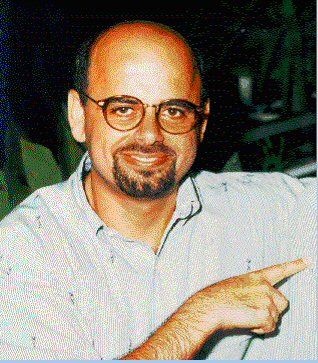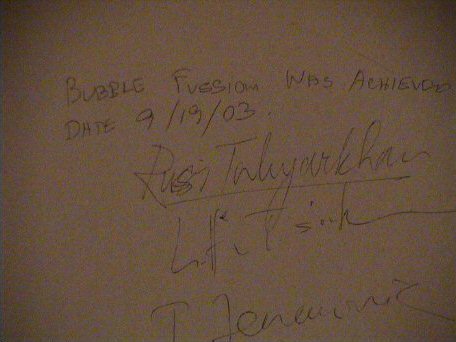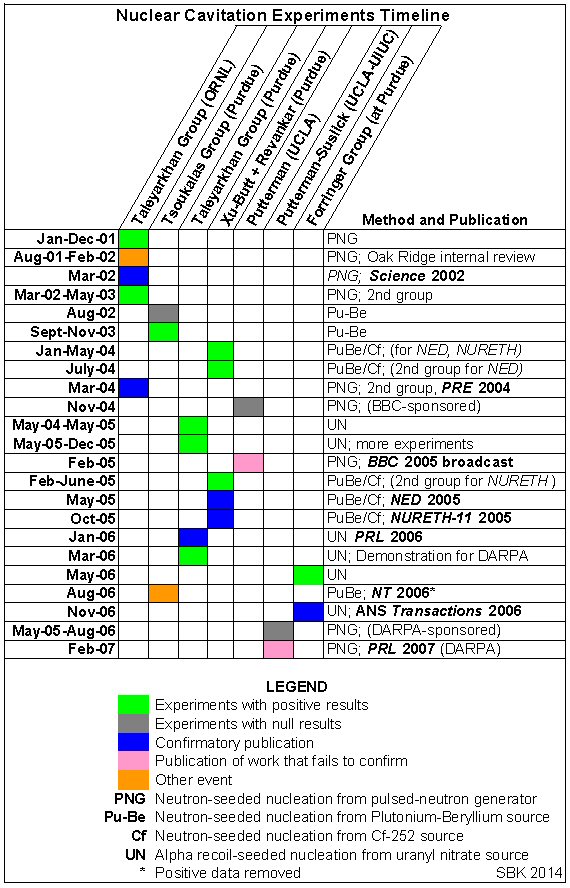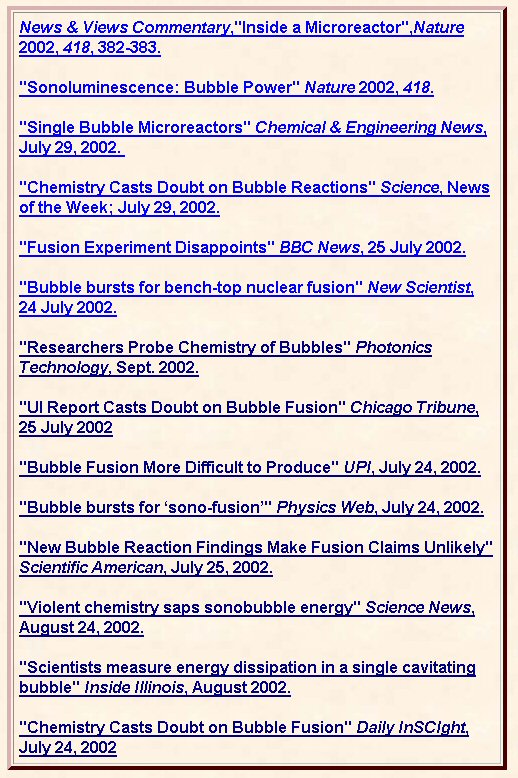Federal Investigations Reveal Academic Backstabbing at Purdue University (Part 3)
First Purdue Replication
In April 2002, a month after the Taleyarkhan group published its research in Science, Tsoukalas put together a group to independently replicate the Oak Ridge nuclear cavitation experiments. The group had a few meetings, and then two graduate students, Anton Bougaev and Joshua Walter, began working on experiments, primarily supervised by Martin Bertodano, a professor in the school. From July 2002 to January 2003, Bougaev and Walter’s experiments were unsuccessful. Either no sustained cavitation was observed, or the chambers broke.
In mid-June 2003, Taleyarkhan agreed to let Tsoukalas send Bougaev and Walter down to Oak Ridge to learn what they could directly from Taleyarkhan and his team. When Bougaev and Walter returned, they brought back with them the required skills as well as chambers made by the glassblowers at Oak Ridge.

Lefteri Tsoukalas
During the summer of 2003, Tsoukalas convinced Taleyarkhan to leave his government job in Tennessee and accept a professorship at Purdue. At the same time, Tony Tether, the head of the Defense Advanced Research Projects Agency, invited Taleyarkhan to work in Washington, D.C., as a program manager for two-to-four years.
Purdue administrators, as well as Tsoukalas, agreed to defer the start of Taleyarkhan’s duties at Purdue while he worked at DARPA for two years, until the fall of 2005. The plan was that Tsoukalas, along with Bertadano and Tatjana Jevremovic, another professor in the school, would take charge and ownership of the nuclear cavitation research while Taleyarkhan was gone. He moved from Tennessee, but as things happened, family health issues precluded Taleyarkhan from leaving Indiana, and he had to decline the DARPA invitation.
Taleyarkhan’s employment at Purdue began in September 2003. He was given an office in the Nuclear Engineering building but was not given a lab. Not until May 2004 did a new off-campus lab space open up for him, and he resumed his own experimental research. In the interim, Taleyarkhan gave advice to Tsoukalas’ group, wrote proposals, and worked on committees. He began teaching assignments in the spring of 2004.
On Sept. 18, 2003, Bougaev and Walter performed an experiment using the Oak Ridge chambers but using normal acetone, one of the scientific controls. JaeSeon Cho, one of the Taleyarkhan group’s members was there on loan from Oak Ridge to help them out. They observed successful cavitation, and it was stable. The next step, now that they had a chamber that would properly support the cavitation, was to replace the normal acetone with deuterated acetone and see whether they could induce nuclear reactions.
On Sept. 19, 2003, they did just that. According to raw data, draft reports, and internal correspondence from Purdue obtained by New Energy Times, Tsoukalas’ group measured confirmatory evidence of nuclear cavitation. This replication, along with the data measured by the Taleyarkhan group, was confirmation of a new class of room-temperature nuclear reactions. The experiment on Sept. 19 was a major achievement. Tsoukalas saw it, and Tsoukalas knew it.
He, Taleyarkhan, and Jevremovic had come to the lab to observe the Tsoukalas group’s experiment. Graduate student Joshua Walter came in first to begin the setup. JaeSeon Cho arrived next. Graduate student Anton Bougaev came in for about a minute. Walter and Bougaev both left by 10 a.m. Cho stayed, ran the experiment, and took data. In anticipation of success, because the chamber had worked the previous day, Taleyarkhan, then later Tsoukalas and Jevremovic, came in to observe. On seeing the excess neutrons emitted from the experiment, the three of them signed the wall on Sept. 19 under the words, “Bubble fusion was achieved here.” By Nov. 14, 2003, the group had run nine experiments that showed excess tritium, the other indicator of nuclear reactions in the experiments.

“Bubble fusion was achieved here. Sept. 19, 2003”
On Sept. 29, 2003, Purdue professor Martin Bertodano, who was working on Tsoukalas’ team, sent an e-mail to his former professor, Richard Lahey, one of the Taleyarkhan group’s members, to share the good news with him.
“I have been wanting to write this email for a long time, but things took a little longer to work than we expected,” Bertodano wrote. “Finally, I can say that we are beginning to get repeatable data. It is not great yet, but it is very encouraging. Our last three seven-hour tests produced positive tritium measurements.”
In his response to Bertodano, Lahey recognized the significance of the replication.
“When you are ready,” Lahey wrote, “an announcement (e.g., at an APS or ANS meeting) by Purdue of independent verification of the ORNL results will surely result in wide media coverage and will likely result in some key funding agencies (USDOE, etc.) becoming seriously interested in bubble fusion.”
In February 2004, post-doctoral researcher Yiban Xu left the Tsoukalas group and began working under the direction of Taleyarkhan. Taleyarkhan’s lab was not set up, so Xu performed his experiments in Tsoukalas’ laboratory, designated as G60, which belonged to the Pharmacy School, from January 2004 through May 2004.
The chart below shows all of the related nuclear cavitation research and associated publications, some of which will be discussed in this report.

On July 1, 2004, Tsoukalas asked professor Martin Bertodano to submit their group’s successful nuclear cavitation replication paper to the October 2005 International Topical Meeting on Nuclear Reactor Thermal Hydraulics (NURETH-11) conference in Avignon, France.
 The Tsoukalas group’s experiment, with some guidance from Taleyarkhan, Cho, and the glassblowers at Oak Ridge, was the first replication performed outside of the national laboratory. Authors of the paper were professors Jevremovic, Bertodano, Shripad Revankar, Tsoukalas, Franklyn Clikeman, reactor supervisor Edward Merritt; Xu; and graduate students Anton Bougaev and Joshua Walter.
The Tsoukalas group’s experiment, with some guidance from Taleyarkhan, Cho, and the glassblowers at Oak Ridge, was the first replication performed outside of the national laboratory. Authors of the paper were professors Jevremovic, Bertodano, Shripad Revankar, Tsoukalas, Franklyn Clikeman, reactor supervisor Edward Merritt; Xu; and graduate students Anton Bougaev and Joshua Walter.
Bertodano told the group about Tsoukalas’ request and sent them a draft abstract. Here is the conclusion of that abstract, followed by a transcription:

“The results with the Beckman detector point to statistically observable tritium increases in post-cavitation deuterated acetone samples,” Bertodano wrote, “suggesting the possibility of D-D fusion taking place. Samples of normal acetone and deuterated acetone not subjected to cavitation do not show statistically observable changes in tritium.”
According to Xu’s sworn statement, the Tsoukalas group had begun omitting the positive data by September. Documents obtained by New Energy Times support Xu’s statement.
“I noted that, in September 2004, Tsoukalas or someone in his group [had] submitted a draft of a paper to NURETH-11 that left out the Beckman Spectrometer readings and data that I had primarily been working on,” Xu wrote. “When I learned of this, around October of2004, I asked that my name be taken off the Tsoukalas et al. paper.”
UCLA Attempts
On the West Coast, a related replication project was under way at UCLA. Between Oct. 7 and Oct. 10, 2004, professor Putterman and his students performed a replication attempt of Taleyarkhan’s nuclear cavitation experiment. It was sponsored by the BBC for a televised documentary. Putterman and Suslick were competing scientists in the race to be the first to experimentally confirm nuclear cavitation. As evidenced by numerous critical e-mails from Putterman and Suslick to federal program managers and derogatory quotes from them in the press about Taleyarkhan’s claim, the BBC’s selection of Putterman was destined to result in failure.
Putterman’s contempt for the Taleyarkhan group’s achievement was no secret and the BBC had to know this. Back in April 2002, a month after the Taleyarkhan group’s first paper published, Putterman made no effort to hide his bitterness after the Taleyarkhan group got there first. In a 2002 news report, Putterman said that he was unconvinced of the group’s results and that he did not intend to try and repeat the experiment himself.
“We will not morph our project in order to reproduce an experiment that provides no new evidence for sonofusion,” Putterman told Physics World.
Regardless, two years later, Putterman accepted money not only from the U.S. government but also from the British Broadcasting Corp. to attempt replications of the Taleyarkhan group’s experiment. Anyone familiar with the subject could have predicted the outcome.
On July 25, 2002, Suslick and his colleagues published a paper about their own research method, single-bubble sonoluminescence. They took the opportunity in the paper to criticize the feasibility of Taleyarkhan’s concept. Suslick measured the temperatures in single-bubble sonoluminescence and extrapolated that data to predict temperatures in multi-bubble sonoluminescence. Based on his prediction, he said that the Taleyarkhan group’s claim was not possible. Suslick’s criticism disregarded the scientific process, which says that experiments overrule theory. The Taleyarkhan group’s measured excess neutrons and tritium trumped Suslick’s speculation, though that did not deter him.
Suslick was adept and aggressive in using the media to promote himself and to attack the work and the credibility of his scientific peers. At one point, he quoted P.T. Barnum on his University of Illinois Web site: “Publicity is good. Good publicity is better.” The Taleyarkhan group was anything but media-savvy. The group did, however, do its best to contain its battles within the peer-review arena of the scientific journals.
As the headlines show, Suslick was extremely effective in leading the media to use his paper as an academic weapon against Taleyarkhan. All the news stories, conveniently for Suslick, omitted the distinction between single-bubble sonoluminescence and multi-bubble sonoluminescence. As Taleyarkhan explained, the latter provides thousands of times more stored energy than the former.

Suslick’s behavior, including public accusations of fraud against Taleyarkhan, suggests Suslick did not fear civil or professional reprisal. Such behavior would normally invite a libel complaint; however, he likely knew Taleyarkhan well enough to predict that Taleyarkhan would not strike back with a lawsuit. He was right, Taleyarkhan didn’t.

